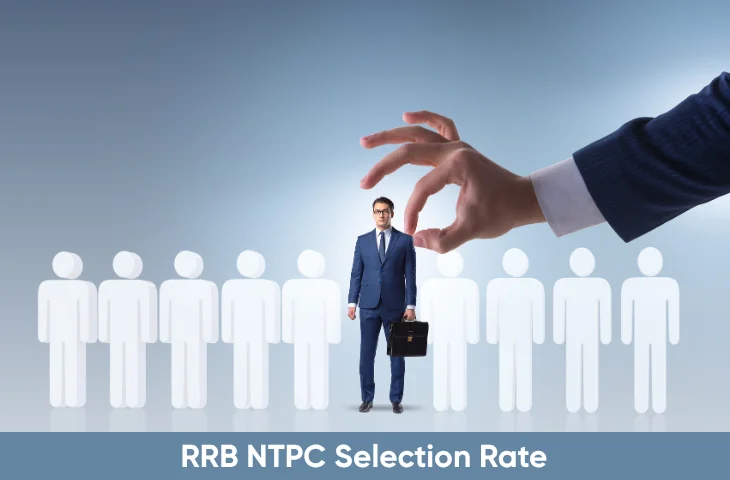Last updated on October 30th, 2025 at 03:51 pm
RRB NTPC Selection Rate: Railway Recruitment Board’s Non-Technical Popular Categories (RRB NTPC) remains one of India’s most competitive government exams. Every year, aspirants ask the same practical question: which levels (pay-matrix levels/posts) give you the best shot at getting selected? This article breaks down how RRB NTPC selection rate is actually determined, why it varies by level, and – using the latest vacancy & process data – which levels tend to show higher selection probabilities in 2024–2025 recruitment cycles.
What Does “Selection Rate” Mean?
Selection rate can mean different things depending on how it’s measured:
- Vacancy-to-applicant selection rate = (Number of final vacancies) ÷ (Number of applicants who applied).
- Shortlist rate after CBT-1 = (Number of candidates called to CBT-2 / next stage) ÷ (Number who appeared in CBT-1). Boards sometimes announce a fixed multiplicative shortlist factor (e.g., 20× vacancies) for CBT-2.
- Final yield = (Number of candidates who actually join after D.V. & medical) ÷ (Number of applicants).
Important Structural Facts that Drive Selection Rate
Certain structural facts drive the RRB NTPC selection rate. Some of them are given below:
- RRBs publish vacancy counts by post / level in each CEN (central employment notice). For 2024–25 cycles the total NTPC vacancies varied by notification (around 8–11k depending on the CEN), split between graduate-level and undergraduate-level posts.
- RRBs typically shortlist multiple times the vacancies for subsequent stages (history examples mention ~20× for CBT-2), meaning initial exam is extremely competitive but only a fraction reach final stages.
- Historical competition ratios are huge – overall success rates (final vacancies ÷ applicants) often fall well below 1% (some analyses have estimated 0.1–0.5% depending on cycle).
RRB NTPC Vacancy Snapshot
The vacancies are mostly released along with the official RRB NTPC Notification PDF. Check out the vacancies for the current and previous years:
| Recruitment Year | Total vacancies | Graduate-Level | Undergraduate-Level | Source |
| NTPC 2024 (CEN) | 11,558 | 8,113 | ~3,445 | News summaries |
| NTPC 2025 (CENs combined) | 8,868–8,875 | 5,810 | ~3,058 | News summaries |
Why Selection Rate Differs by Level?
The RRB NTPC Selection Rate differs by level due to factors like applicant profile, vacancies, and more. Given below are the details:
- Vacancy concentration: Some posts/levels (e.g., certain graduate posts like Goods Train Manager or Junior Accounts) have large block vacancies in specific zones – larger vacancy pools improve individual selection probability for those who apply to those zones/posts.
- Applicant profile & interest: High-prestige, higher-pay levels (senior posts) attract more applicants per vacancy. Conversely, less glamorous posts or those limited to particular educational backgrounds may see fewer applicants relative to vacancies.
- Different eligibility & post-specific tests: Some posts require additional skill tests (typing, aptitude), letting better-matched candidates filter through – this can raise the effective selection rate for those with the required skill.
- Shortlist multipliers & normalization rules: Because RRBs use normalization across multiple shifts and fixed shortlist multipliers, a level with more vacancies may see more candidates called through proportionally – raising its shortlist rate though not necessarily final yield.
Which Levels Usually Show Higher Selection Rates?
The undergraduate level posts usually show higher selection rates. Using the structural factors above, these broad patterns are observed across cycles:
- Levels with many vacancies (mass recruitment posts) – e.g., certain Graduate posts like Goods Guard / Goods Train Manager and major clerical roles – usually produce the highest raw selection probability, because vacancies are larger and competition per vacancy is relatively lower. (Large vacancy pool = higher odds.)
- Undergraduate-level posts (12th pass) such as Commercial Cum Ticket Clerk, Junior Clerk) – often have decent selection rates compared with niche graduate posts, because aspirant pools for UG posts are large, but vacancy blocks can also be big in some zones. Net effect: selection rate varies zone-wise.
- Highly sought graduate posts with limited openings (like Station Master in some zones, or specialized roles) – lowest selection rate because applicant interest is concentrated.
- Post-specific skill roles (typing, aptitude): candidates with those skills can enjoy comparatively higher effective selection rates – skill acts as a filter in their favour.
Steps to Improve your Personal Selection Probability
Check out the steps to improve your personal selection probability:
- Apply selectively to zones/posts with larger vacancy pools. Larger vacancy blocks increase odds. (Check the CEN’s zone-wise vacancy table.)
- Choose posts where required skills match yours. If you’re a fast typist, target clerk/typist posts that include a typing test – you’ll clear a key filter.
- Maximise CBT scores, not just pass marks. Final shortlisting often depends on normalized scores; higher percentile pays off.
- Track shortlist multipliers & cut-offs from previous zones – they help estimate how many will be called for CBT-2 per vacancy. Historical notifications sometimes fixed 20×; verify current CEN.
Summary
The main points of the article are summarized below for the applicants:
- “RRB NTPC Selection Rate” depends more on vacancy distribution than on the level number. Levels with larger vacancy pools typically show higher raw selection probabilities.
- Shortlisting multipliers (historically up to 20× at certain stages) mean CBT-1 is eliminationist – your CBT-1 score must be competitive to be in the shortlisted batch.
- Overall success rates are tiny when measured as final vacancies ÷ total applicants (often well under 1%). Expect stiff competition; target zones/posts strategically.
- Post-specific skills (typing, aptitude) can significantly improve your effective selection chances.
If your objective is to maximize real chances of selection (not prestige), aim for levels and specific posts that offer larger vacancy blocks (mass recruitment posts) or where your skill set gives you an edge (typing/aptitude). Always cross-check the current CEN and zone-wise vacancy PDFs (official RRB CEN documents are authoritative), confirm shortlist rules for that cycle, and prepare to score well in CBT-1 since shortlist multipliers make the early stage the primary gatekeeper.
FAQs
The RRB NTPC Selection Rate refers to the ratio of candidates finally selected for a post compared to the total number of applicants who applied or appeared for the exam. It indicates how competitive each level or post is. For example, if 1,000 candidates are finally selected out of 2,00,000 applicants, the selection rate is 0.5%.
Levels with larger vacancy pools generally have a higher RRB NTPC Selection Rate. For instance, posts like Goods Guard, Commercial Apprentice, or Senior Clerk cum Typist (Graduate Level) often offer more vacancies across multiple zones, increasing the overall chance of selection compared to posts like Station Master which have fewer seats and higher competition.
No, the RRB NTPC Selection Rate varies from one zone to another because each RRB has different vacancy counts, applicant numbers, and cutoff trends. For example, RRBs with more vacancies (like Allahabad or Secunderabad) often see slightly better selection probabilities compared to smaller zones with limited seats.
Several factors influence the RRB NTPC Selection Rate, including:
Total number of vacancies announced in that year’s CEN notification.
Number of applicants per zone and post.
Difficulty level of the CBT exams.
Shortlisting multiplier used by RRB (e.g., 20× rule for CBT-2).
Number of candidates who qualify typing or aptitude tests (for specific posts)
To improve your personal RRB NTPC Selection Rate, focus on:
Applying for posts and zones with higher vacancy counts.
Scoring well in CBT-1 to secure a place in the 20× shortlist.
Preparing thoroughly for post-specific skill tests (typing/CBAT).
Practicing with previous year papers and taking mock tests regularly.
Following an AI-driven or structured study plan to identify weak areas early.
- RRB NTPC City Intimation Slip 2025, Check Exam Centres
- RRB NTPC Medical Test 2025, Check Post Wise Medical Criteria
- RRB NTPC Undergraduate Notification 2025, Apply for 3058 Posts
- RRB NTPC परीक्षा के लिए स्टेटिक जीके टॉपिक, यहां जानिए सभी टॉपिक्स
- RRB NTPC vs SSC CGL vs IBPS Clerk, Check Complete Analysis
- Importance of RRB NTPC Psycho Test, Know the Details of Test

Hello! This is Arijit Dutta. I am a skilled Content Writer at Oliveboard with nearly 3+ years of experience in crafting engaging, informative, and exam-focused content for the Railways Domain. With a strong command of language and a keen understanding of learner needs, I contribute significantly to Oliveboard’s mission of delivering high-quality educational resources. Passionate about clear communication and continuous learning, I consistently create content that helps government job aspirants achieve their goals. Outside of work, I enjoy playing cricket and listening to music, which helps me stay balanced and creative in my professional journey.
